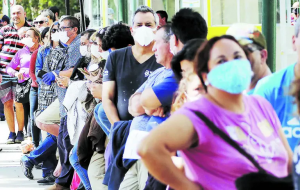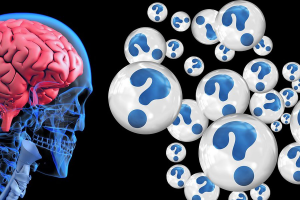
On May 13, Patricio Orio, researcher at the Centro Interdisciplinario de Neurociencia at the University of Valparaíso (CINV), referred to his studies on the brain and its mechanisms to face some situations, in an interview with Francisco Aravena and Polo Ramírez in the program “Aire Fresco” from Radio Duna (89.7 FM)
Interview Date: May 13, 2020
Translated by Macarena Churruca
 People who hoard food disproportionately or the hundreds or so who drank chlorine in the U.S. may portray that behavior. Extreme responses arise when humans perceive their survival threatened and need to regain control.
People who hoard food disproportionately or the hundreds or so who drank chlorine in the U.S. may portray that behavior. Extreme responses arise when humans perceive their survival threatened and need to regain control.
Published on May 07, 2020 at La Tercera
By Paulina Sepúlveda
Our brain operates by predicting more than 80% of the tasks we perform on a daily basis. This is a capacity acquired during centuries of evolution. This is an advantage that allows us to make the most appropriate decisions in a very dynamic world.
For example, at a sensory level, the ability to anticipate what will happen allows our neurons to process information more efficiently and helps our bodies save energy.
In the long term, this ability to make decisions for the future and to anticipate, is what the experts say has separated the human species from the rest of the animals.
However, that ability is stretched out nowadays and the cause is the pandemic, says Patricio Orio, a researcher from the Centro Interdisciplinario de Neurociencia (CINV) at the University of Valparaíso, who explains that the lack of certainty in the global health scenario – with hundreds of millions of people in confinement, many with their jobs threatened – challenges our ability to plan for the future.
Some examples are: people who hoard food disproportionately or the hundred or so who drank chlorine to fight the new coronavirus in the United States, as Donald Trump first suggested. Extreme responses arise when humans perceive their survival threatened and need to do something to regain control.
“Confinement and distress have a lot to do with what is subverted right now, which is our ability to make predictions about the future”, and it is not, he says, about governments and authorities, who cannot make accurate predictions, but about the citizen who sees his work threatened or the student who does not know when he will be able to return to the University. “We are all in a situation with little certainties,” says Orio, and our brains resent that.

Orio studies the brain’s multi-stability mechanisms, a characteristic of neural circuits that would be the basis for adaptability to new scenarios and the search for new solutions. An elasticity that the brain develops even in the absence of external stimuli and even when there is no apparent activity, such as when we are sleeping.
A Study of the CINV,, led by the academic and published by the international journal Chaos, investigated how this dynamic emerges even in simulations of neural networks, where there are chaotic and random components.
In such a complex and unknown scenario, a differential factor could lie in the adaptive capacity of our brain, and the strategies that individuals use to modify their usual state. “It is one of the reasons why it is convenient to have a brain capable of configuring and reconfiguring itself in different ways,” says Orio.
Predictive machine
The brain can be compared to an predictive machine. This evolutionary mechanism originated to try to predict what our senses will perceive before it happens. “All our sensory systems (vision, hearing, touch, etc.) are constantly operating under this dynamic, which reduces the amount of information to be processed because most of the time the prediction is fulfilled,” says Orio.
An example of this at a sensory level is when we drive it takes only a brief glance to know the cars that are around. Sometimes though, we must correct our expectations about the environment, says the researcher, although in this process, sensory illusions are also generated. “In fact, most ‘magic tricks’ are based on deceiving ourselves using our sensory expectations,” he explains.

“According to several researchers, our taste for music and various forms of games are a strategy to train the brain’s predictive ability. In both music and games, there are rules and predictable events within which small unexpected situations could arise and provoke pleasure as well,” he explains.
But the brain has also evolved to plan for the short and long term using our abstract thinking skills. Humans have surpassed other species, the researcher explains, because our abstract thinking capabilities gave us the possibility to predict what is going to happen in the long term to make plans for months or even years ahead.

Today this is an unstable survival strategy. Orio explains: “In quarantine, we are certain that tomorrow the sun will rise, but not when we will be able to go back to school or when we are going to have our jobs back. This unpredictability affects some people more than others. For many it’s simply a source of stress because the brain feels it can’t do its job”.
The threat to certainties and to our ability to keep things under control awakens stress mechanisms such as anxiety and panic, useful in short-term responses such as escaping from a fire or evacuating a coastal area after an earthquake. But in a pandemic scenario, spread out over months, Orio says, “this could lead to irrational responses.
The capacity to predict is what gives us the feeling of being in control. “You are in control of something when you know that if you move the steering wheel to the right, the car is going to turn to the right. To be in control is to be aware that our predictions are actually happening. Control is being able to know that if I drop a ball it will fall. If I drop a ball and it floats away, defying my prediction, that’s when I lose control,” says Orio.
The scenario of panic and loss of control might be explained by the interaction of various areas of the brain. A central role in this process is played by the cerebral tonsils, a group of neurons located deep in the temporal lobes of all complex vertebrates.
The amygdala is part of the limbic system and its main role is in the processing and storage of emotional reactions. It works by sending projections to the hypothalamus, the region where the autonomic nervous system is activated. Some researchers point out that even its size is linked to our ability to socialize.
The panic is originated when the amygdala, which is the emotional center of the brain, prompts us to escape immediately from the threat. Its response is opposed to that of the frontal cortex -which decides our behavior- that urges us to think rationally about the situation. For this, it seeks to connect with all areas of the brain related to planning and decision making, according to Orio.
But this process can become chaotic when anxiety appears. The frontal cortex gets confused among the multiple cross interactions and comes into contact with those regions that represent the worst possible scenarios. “From this short circuit, which makes the most rational part of our brain begin to be governed by emotion, panic arises,” he says.
The search for balance
However, the researcher states that panic does not contribute to overcome the threats in the long term. It is at these stages that it is most important for the frontal cortex to remain under control, alerting the individual to the possibility of a threat and taking the time to assess the risk and make a plan for action.
In this sense, “the balance between irrational or rational behavior is key to regaining control. Given scenarios such as the current one, most of the time the brain operates by making an adjustment in this direction, interpreting reality by making use of one’s own beliefs or by assessing the reception of new evidence,” he explains.

These are the two tools we have to regain control. Depending on how subjects are configured, they will make more use of one or the other, says Orio. Factors such as training, personality or even the strategies used in the past to solve problems can guide the response in one direction or another.
“In such environments where rules are constantly changing, it is valuable to know how to incorporate these changes and adapt to scenarios by evaluating new evidence. But all extremes are bad: constant evaluation of reality, re-judging all the information we receive also generates more anxiety and distress.
In fact, it is one of the characteristics of schizophrenia. On the contrary, the person who always stays with his premises will not be able to adapt to a new context,” he details.
Analyzing new evidence and forming a new perception takes time. In fact, the brain cannot do so when emotional responses are activated. There, it turns off the information that enters and activates basic mechanisms such as running away, fighting, or staying still. Usually, survival responses will always be guided by established patterns because it is faster and more efficient.
“When the brain is relaxed, it has time to re-evaluate the evidence and acquire new patterns and behaviors. During stressful episodes the things we learn, are learnt deeply. Every time there is an event of anxiety, danger or stress learning is not rational but rather emotional” he says.
Read this interview at La Tercera



 People who hoard food disproportionately or the hundreds or so who drank chlorine in the U.S. may portray that behavior. Extreme responses arise when humans perceive their survival threatened and need to regain control.
People who hoard food disproportionately or the hundreds or so who drank chlorine in the U.S. may portray that behavior. Extreme responses arise when humans perceive their survival threatened and need to regain control.